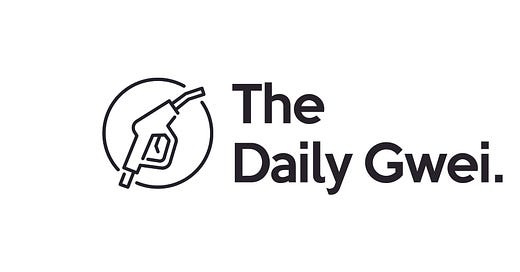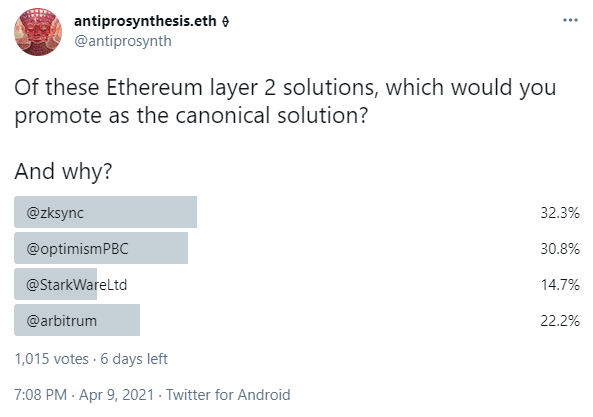One concern that I’ve seen many people in the Ethereum community bringing up over the last few months is that the layer 2 ecosystem is already becoming too “fragmented”. People think this because we currently have a few different scalability solutions all on-boarding different apps which is creating some silos.
Source: https://twitter.com/antiprosynth/status/1380447525207998464
Let’s take a look at the solutions that antiprosynthesis mentions in his poll and see where they stand today. zkSync is a payments based layer 2 that has been integrated with Gitcoin for some time now - the team also plans to launch EVM-compatibility in the near future. Next is Optimism which is currently home to Synthetix (in its early stages) and have announced that they are working with “about a dozen” projects (including Uniswap of course). StarkWare’s technology is being used to power exchanges including dYdX, Immutable X and DerversiFi. Lastly, Arbitrum (which isn’t on mainnet yet) has deployments of Balancer, Bancor, MCDEX and more on their optimistic rollup solution.
So, as you can see, we do indeed have a fair bit of fragmentation already across the layer 2 ecosystem. Though, I personally think this is actually a great thing given how early we still are here in the layer 2 roll-out. You can think of what’s happening in the layer 2 ecosystem right now as the “adoption and innovation” phase where many different solutions are being tried and tested at once in parallel. Of course, not all of them will succeed over the long-term, but those that do will go on to see massive growth and usage as the hunger that users and applications have for scalability is insatiable. The big winners will be those that can cultivate an ecosystem of high-demand apps and have infrastructure built around them for easy onboarding (such as CEX on-ramps).
In addition to the above, there are other Ethereum scalability solutions such as plasma (Matic), commit-chains (Polygon PoS), state channels (Connext) and “sidechains” which can essentially be any layer 1 that bridges into Ethereum. I think these solutions have their place and I’m really excited about those that are very additive to Ethereum and ETH like the Polygon PoS chain as it uses Ethereum as part of its security structure and Connext as it allows for bridging of layer 2’s. The design space here is vast and it really is all about the different trade-offs and security assumptions that app developers and users are comfortable with.
Ultimately I don’t think there will be just one solution that “wins” the scalability wars. As I said, each scalability solution comes with its own trade-offs, trust assumptions and general strengths & weaknesses. Some are really good for payments, some allow for EVM-compatability and some offer greater scalability at the cost of decentralization. Of course, at the end of the day, the real winners of the scalability wars will be the end-users who will be getting all the benefits of Ethereum apps without any of the high cost and low throughput downsides!
Have a great weekend everyone,
Anthony Sassano
Join the Daily Gwei Ecosystem
All information presented above is for educational purposes only and should not be taken as investment advice.






I like the conclusion of the article.
To me the wars are not about scalability solutions against each other but rather between the decentralized permissionless systems and the centralized permissionless system.
Cheap-to-use EVM-compatible systems are likely to be the first choice for the users, at least for the next few months, and we want EVM-compatible solutions that can inherit Ethereum security so current projects can go there instead of BSC - which although centralized would make sense for those projects interest.
That would give enough time to proceed to the next stage of L2 where EVM compatibility might become less important as some projects can afford to migrate to domain-specific L2 that makes sense for them, and still on top of ETH (or any sufficiently decentralized system that would exist at that point)
Curious as to why ZKRollups/ Loopring type L2 which is already in production has been excluded especially since Vitalik is most optimistic about ZKRollups as the long term solution he finds most promising?